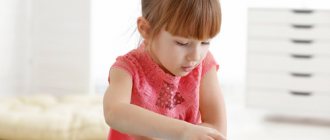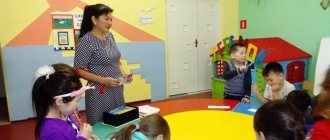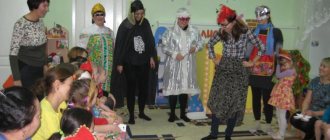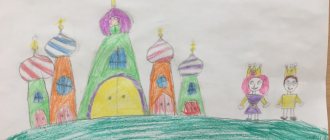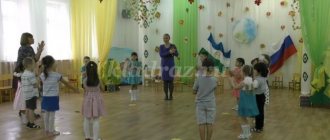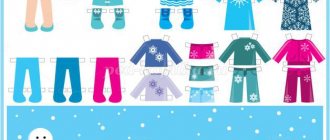Abstract of the NOD “Russian folk tale “Kolobok””
Summary of direct educational activities for the implementation of the educational field “Speech development” (speech development) in a mixed-age group.
"Russian folk tale "Kolobok""
Kazarinova-Dokuchaeva Ekaterina Dmitrievna
Tasks:
Educational:
Expand children's understanding of the topic "Fairy Tale".
Developmental
:
Develop variable thinking, speech, memory, attention, imagination, ability to analyze.
Develop the ability to play a role.
Develop the skill of noticing inconsistencies in the conveyance of the content of the text when listening to the story of comrades.
Educational:
Foster a sense of respect for the artist.
Speech:
Coherent speech: learn to answer the teacher’s questions with a complete answer, making grammatically correct sentences; develop prediction skills.
Dictionary: subject - fairy tale, heroes, viewer, character; qualitative –
cunning, big gray, eared; verbal – tell, speak, listen..
Grammar: continue to teach children to form new words for plural nouns.
Sound culture of speech: develop children's auditory concentration.
Individual work:
Encourage the use in speech of compound and complex sentences and elementary methods of word formation.
Methods and techniques:
Practical: a surprise moment - pay attention to the illustrations, theatrical activities.
Visual: illustrations for fairy tales, hero masks.
Verbal: conversation, theatrical activity.
Materials:
illustrations, audio recording, hero masks, screen
Progress of the lesson
The teacher draws the children's attention to the illustrations for the fairy tale. Children sit in a semicircle.
Educator:
guys, look who is shown in the pictures? What fairy tale are these characters from? Is this an author's fairy tale or a Russian folk tale?
Children's answers (kolobok, grandfather and woman, bunny, wolf, bear, fox; kolobok; Russian folk)
Educator:
right. Well done. You are very observant. I want to remember this fairy tale with you.
The teacher begins to tell a fairy tale. The children take turns continuing the story.
Educator:
Well done. We remembered the whole fairy tale. I have a surprise for you.
The teacher demonstrates masks-heroes of the fairy tale.
Educator:
These are masks. With their help, you and I will turn into fairy tale heroes and show the children a performance.
The teacher selects children from 4 to 6 years old. They will perform. The rest of the children will be spectators. Children choose their own mask. All the heroes go behind the screen.
Educator:
our artists behind the screen. The artists will perform on stage. You are the audience. I will be the narrator and sound engineer. Begin.
Children-heroes show the fairy tale, the rest of the children play the role of spectators, the teacher is the narrator and sound engineer.
Educator:
Oh. What a wonderful fairy tale it turned out to be. Let us thank the artists with applause.
Children clap their hands. The performers behind the scenes take off their masks and sit on the carpet.
Educator:
Who was your favorite character? What was the most interesting thing?
Children's answers (the fox is beautiful and cunning. The wolf growled loudly. The bear stomped angrily).
Educator:
Well done boys! I suggest you take pencils and coloring books.
Next is the independent activity of children - visual activity.
MAGAZINE Preschooler.RF
Author: Ozerova N.A. teacher of the 1st qualification category Moscow 2014 Types of children's activities: productive, gaming, musical and artistic, reading fiction, communicative. Goals: to consolidate children's knowledge of Russian folk tales; arouse interest in listening to a literary work. Objectives: educational: develop children’s speech, enrich vocabulary; consolidate knowledge of the characters of the fairy tale, the sequence of events of the fairy tale, encourage children to participate in reciting the text of the fairy tale together with the teacher, and its dramatization; continue to learn to coordinate movements with speech, distinguish between emotions, and depict them using facial expressions, gestures, and movements. developmental: development of interest in theatrical games, development of the ability to act on command, develop emotionality of speech, attention, mental operations; educating: evoke an emotional response, cultivate a love of nature, folk art, a desire to help; develop the ability to work in a team. Methods: verbal, visual, practical, game; methods that increase emotional activity (stimulating the manifestation of cognitive interests), reproductive methods (cognitive activity). Techniques: immersion in a game situation, group work and individual work, questions, asking riddles, a surprise moment. Preliminary work: familiarization with the text of the fairy tale; examination of illustrations for a fairy tale, illustrations on the topic “wild animals”; artistic creativity: modeling a “bun”, drawing “a gingerbread man is rolling along the path”; conducting outdoor games using emblems of wild animals (fox, hare, wolf, bear); Leisure time for physical development “Visiting the Kolobok”. Material (equipment): flannelgraph, music center, fairy tale characters (planar), emblems of bunnies and foxes (fox hat), toy bun, floor Christmas trees. Progress of the lesson: Educator: Everyone stand in a row, Let's play together. Get your ears and eyes ready, Let's begin our fairy tale: “Once upon a time there lived a cheerful little bun, He left his grandmother, He left his grandfather, he rolled down the path and ended up in our group.”(the teacher removes the bun from the flannelgraph). (The phonogram sounds: oh-oh-oh, we see the bun that ended up in our house). Educator: Who is that hiding in the house? (Kolobok). Kolobok: Yes, I am a Kolobok, hello children (the children greet the Kolobok). Educator: Kolobok, Kolobok, how did you get into our house? Kolobok: It didn’t lie on the window, it rolled along the path. I got a little lost, so I ended up in your kindergarten... It’s nice here, cozy and warm, with a lot of toys. I like it here, can I stay with you? Educator: The bun will stay with us and tell us his fairy tale. Kolobok: Okay, just help me, tell a fairy tale with me! (the teacher and the children begin their journey into a fairy tale). Kolobok: We have a long journey ahead of us, let’s play a little, show me guys how I turned out (Finger gymnastics)
I am a bun, a bun (circular movements with palms)
Scraped along the bottom of the barrel (with the right hand they “scrape” the left hand)
Sweeping around the barn (simulate sweeping)
On sour cream meshen (make circular movements with your right hand)
Sazhen into the stove (show two arms extended forward)
It's cold on the window (they show the window with both hands)
I left my grandmother, and I left my grandfather (the index and middle fingers of the right hand run along the palm of the left).
Educator: Along the path, along the path, (Children run in a circle)
Between the pines left, right,
Very fun, playful
The bun rolled.
He rolled around, got lost, and met a hare: Hare: hello dear little bun, what are you doing in the forest? Kolobok: I am a cheerful Kolobok, I have a ruddy side, I didn’t lie on the window, I rolled along the path. I left my grandmother, I left my grandfather, I got lost in the forest, I can’t get home, guide me, scythe!
Bunny: what should I do with you, oh well, I’ll see you off, just play with me! (children play the outdoor game “The little gray bunny is sitting” 2-3 times). Kolobok rolled on, and the bunny hopped and hopped with him!
Educator: He rolled there,
Where I have never been.
He rolled, didn’t get bored,
The bunny was jumping nearby, suddenly a wolf came out from behind the bushes to meet them!
Wolf: Hello, hare! who is your friend?
Kolobok: listen, gray Wolf, answer: I have no secrets! I am a cheerful Kolobok, I have a ruddy side, I did not lie on the window, I rolled along the path. I left my grandmother, I left my grandfather, I got lost in the forest, take me home!
Educator: the bun rolled further, next to it was a gray wolf. They met a bear (They depict a bear).
Bear: what are you doing in the forest? (the bear says to the kolobok).
Kolobok: I am a cheerful Kolobok, I have a ruddy side, I didn’t lie on the window, I rolled along the path. I left my grandmother, I left my grandfather, I got lost in the forest, take me home!
Bear: Bear is very angry
He stamped his big paw.
-You left your grandmother (they shake a finger),
And he left his grandfather (they shake a finger),
Rolled around, got lost,
You are so naughty! We need to take you home!
Kolobok: don’t be angry, bear, let’s play with you! (game “The clumsy bear walks through the forest...”).
Educator: the bun rolled further, next to it was a clumsy bear. Here to meet them, a fox!
Fox: - Hello, bun! How cute you are! Where are you going?
Kolobok: I am a cheerful Kolobok, I have a ruddy side, I didn’t lie on the window, I rolled along the path. I left my grandmother, I left my grandfather, I got lost in the forest, take me home!
Fox: play with me, my friend! (game "Fox and Hares"). Educator: He began to play with the little fox and run away quickly. There is no red fur coat in the forest, There is no more cunning beast in the forest. Don't joke with the Fox, but run home quickly (the bun runs away from the fox). Kolobok: Well, guys, we told a fairy tale, and we played with the fox.
Educator: Guys, let's play with the kolobok and remember which heroes he met in the forest. Physical education minute. It was baked from flour, (we make a pie with our hands) It was mixed with sour cream. (knead the dough) He was chilling in the window, (we blow on his palms) He rolled along the path. (we run in a circle) He was cheerful, he was brave. (we smile, we walk) And on the way he sang a song (we sing a song, la-la). A little bunny met him (we jump like a bunny). Gray wolf and brown bear (show the wolf, waddle around like a bear). And when the baby is in the forest (we walk). I met a red fox (we show the habits of a fox). He ran away from her. Educator: Well, we’ve played, it’s time for the bun to return to the fairy tale, grandparents are waiting for him. Let's say goodbye! kolobok. Kolobok: Kids, I thank you! And I say “thank you” to everyone! Now I'm hitting the road, I'll definitely come back to you. Children: Goodbye! Educator: Grandfather and grandmother are very glad that Kolobok has returned to them and they have prepared a treat for the children and guests (the children sit at the tables where a treat has been prepared for them in advance).
| Next > |
Summary of a lesson on speech development for the second junior group “Reading the fairy tale “Kolobok”
Gavrichkova Ksenia
Summary of a lesson on speech development for the second junior group “Reading the fairy tale “Kolobok”
Goal: To introduce children to the Russian folk tale “ Kolobok ”
, introduction to oral folk art, continue to teach children to carefully examine illustrations in books.
-development of coherent speech and enrichment of children’s vocabulary;
-development of attention and memory of children;
-education for Russian folk tales ;
-development of the ability to describe what is seen.
3. Type of lesson : combined.
4. Form of lesson : reading-discussion .
5.Duration: 15 minutes.
6.Age of students: 3-4 years.
7.Equipment and materials: books with the fairy tale “ Kolobok ”
different artists, toy
bun .
-verbal: reading fairy tales , children's stories , conversation;
-visual: looking at illustrations.
9. Lesson .
1. Introductory part Checking the readiness of children for the lesson (appearance, concentration of attention)
1 minute
2. Main part Organizing children's attention (a surprise moment, reading a fairy tale and looking at illustrations in books. 10 minutes.
3. End of the lesson Summing up : description of the fairy tale by children using a mnemonic table and assessment of children’s participation. 4 minutes
10. Lesson progress
The chairs in the group are placed in a semicircle, the children sit on the chairs.
There is a knock on the door. The teacher opens and asks the children a riddle:
-It was baked from flour,
It was mixed with sour cream,
He was chilling at the window,
He rolled along the path.
He was cheerful, he was brave
And on the way he sang a song. Who is this?
-Right. This is a bun . (Teacher shows a toy kolobok )
.
-Who knows the fairy tale about our kolobok ?
-Let's read a fairy tale about our guest , I think he will be pleased with our interest.
The teacher reads a fairy tale , trying to convey emotions.
-Are you tired? Let's relax a little and play with our hands. Repeat after me .
-Knead the dough quickly (open and close your palms,
- Divided into pieces (simulate pinching off,
-Roll out all the pieces (three palms together)
-And we made little buns (we show 2 fists)
-Now let's go to the table. What lies on it? - Books.
-That's right, books about our hero. different artists depicted . (Children look at books with images of koloboks .)
-Which bun did you like best and why?
Children answer and describe.
3. End of class .
-We looked at the illustrations, told why we liked the koloboks , and now let’s repeat the fairy tale .
Next, the teacher gently evaluates each child’s participation.
Children tell a fairy tale .
Summary of a lesson on speech development in the senior group “Reading the fairy tale by D. Rodari “The Cunning Pinocchio” Summary of a lesson on speech development in the senior group on the topic: Reading the fairy tale by D. Rodari “The Cunning Pinocchio”. Implementation of program content.
Summary of educational activities for speech development in the second junior group “Reading poems by S. Ya. Marshak from the cycle “Children in Cages” Topic: “Reading poems by S. Ya. Marshak from the cycle “Children in Cages”. Objectives: Educational: to arouse children's interest in listening to poetry. Summary of an open lesson on speech development. Reading the fairy tale “The Great Cold” by S. Prokofieva. Summary of an open lesson on speech development. Reading the fairy tale by S. Prokofieva “The Great Cold” Purpose: To please children by reading a new fairy tale by S. Prokofieva.
Summary of an open lesson in the middle group on speech development “Reading the Russian folk tale “The Little Fox and the Gray Wolf” Purpose: To introduce children to the Russian folk tale “The Little Fox and the Gray Wolf”, to help evaluate the actions of the heroes. Preliminary work:.
Summary of a lesson on speech development in the second junior group “Reading the Russian folk tale “The Fox and the Hare”” Gorskaya Natalia Yuryevna Summary of speech development in the second junior group Reading the Russian folk tale “The Fox and the Hare” Objectives: To introduce.
Summary of a lesson on speech development. Telling the fairy tale “Kolobok” using the modeling method. Summary of a lesson on speech development in the second group of early age. Telling the fairy tale “Kolobok” (using the modeling method).
Source
